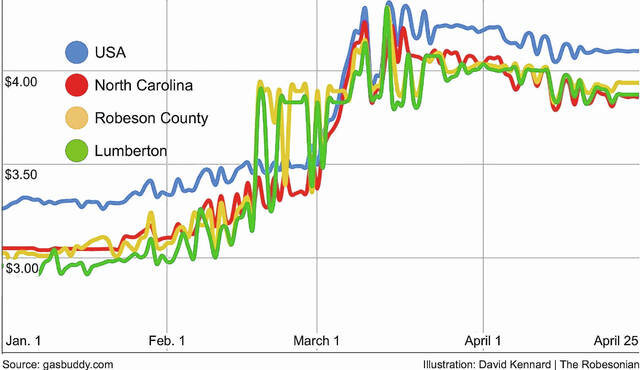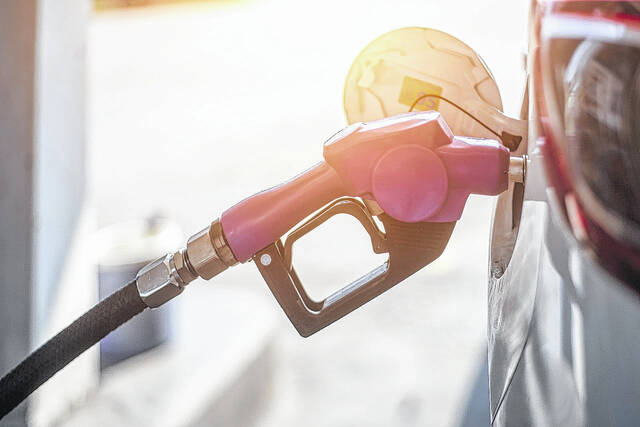
Drivers have seen the price of gasoline drop from a mid-march high to an average low of $3.83 per gallon in Lumberton on Monday.
Drivers have seen the price of gasoline shift wildly in recent weeks, dropping from a mid-march average price of $4.34 per gallon to Monday’s average low of $3.83 per gallon in Lumberton.
While still much higher than this time a year ago when local gas stations were posting the price per gallon at $2.45, drivers now consider any drop in price a move in the right direction.
Lumberton gas stations have consistently posted lower prices than the rest of Robeson County as well as stations around the state and nation.
Nationally, Monday’s average high was $4.11 per gallon. But drivers in some of California’s biggest metro areas were paying $5.78., which was actually greeted as a relief Monday from an average price of $6.06 per gallon in mid-March in Los Angeles.
Locally, since Jan. 1, Lumberton drivers have seen prices inch upward from just under $3 per gallon, although economy watchers are suggesting the prices will continue to increase in coming weeks.
According to a press statement released Monday by AAA, the recent dip in pump prices has reversed, with upward pricing pressure coming from concerns that less Russian oil will enter the global market. That’s combined with fear of a COVID-induced economic slowdown in China, the world’s leading oil consumer.
“These opposing forces are causing the oil price to hover around $100 a barrel,” according to the prepared statement.
“As long as the price of oil stays elevated, the price at the pump will struggle to fall,” said Andrew Gross, AAA spokesman. “Consumers may be catching a little break from March’s record-high prices, but don’t expect any dramatic drops.”
Officials with AAA stated that new data from the Energy Information Administration (EIA) shows total domestic gasoline stocks decreasing by nearly 1 million barrels of crude oil (bbl)to 232.3 million bbl last week. In that same report AAA pointed to gasoline demand, which has increased slightly from 8.73 million b/d to 8.86 million b/d.
“Although supply and demand factors would have typically supported elevated pump prices, the fluctuating oil price continues to be the main factor influencing prices at the pump, according to Gross.
North Carolina’s prices are similar to other predominantly Southern states, according to Monday’s report showing the nation’s top 10 least expensive markets: Georgia ($3.71), Arkansas ($3.74), Missouri ($3.75), Ohio ($3.75), Kansas ($3.77), Oklahoma ($3.77), Mississippi ($3.77), Texas ($3.77), South Carolina ($3.78) and Kentucky ($3.79).
“For the first time in over a month, the national average price of gasoline has risen,” said Patrick De Haan, head of petroleum analysis at GasBuddy.
“Primarily, this was due to oil prices that had jumped the prior week, pushing up the price that stations pay for fuel and thus causing them to raise prices.
“The rise has been quite tame in most areas, while others have continued to gently decline.” De Haan stated on Monday. “But, with the French election now behind us, there is risk that the EU could pursue harsher sanctions on Russia’s energy, which could cause oil prices to rise if it happens – something motorists should be on the watch for.
“In addition, U.S. oil inventories continue to decline, putting additional pressure on prices as the nation’s SPR continues to drain and Russia’s war on Ukraine remains ongoing,” De Haan stated. “The global imbalance between supply and demand that led to these higher prices continues for the time being.”
The Robesonian’s David Kennard contributed to this report.









